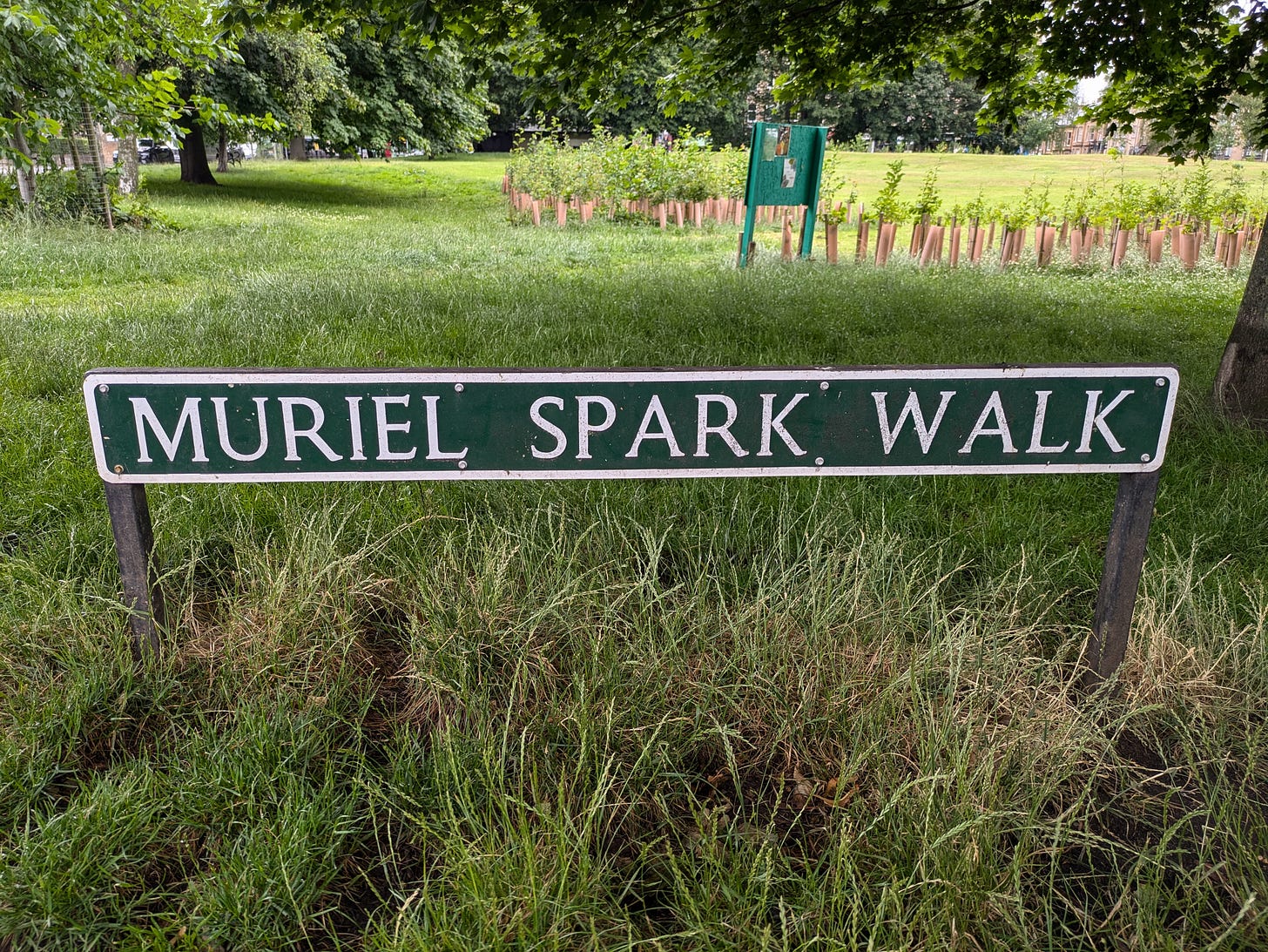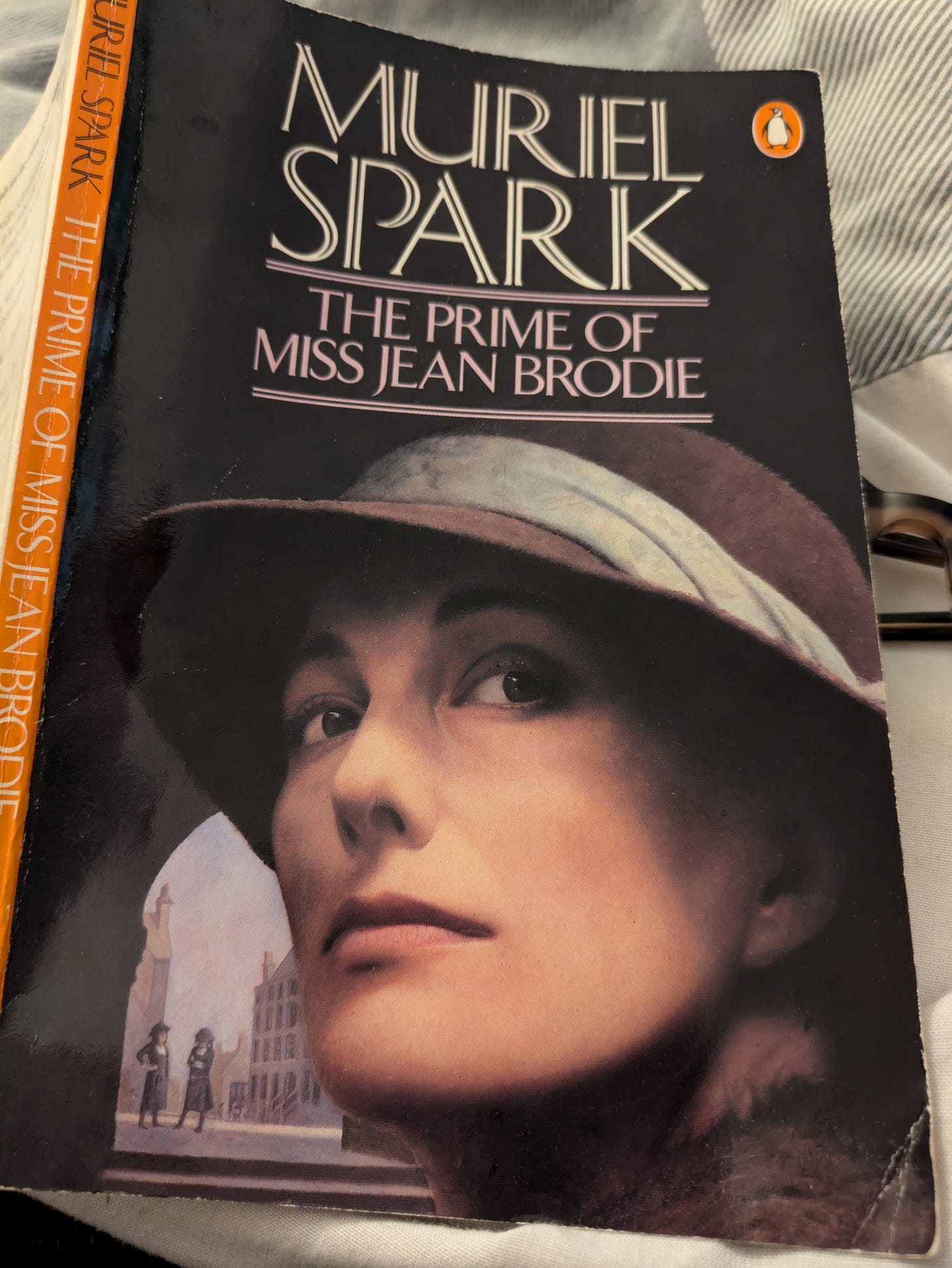Was Miss Jean Brodie so unlikely?
A strange brew of Edinburgh gentility, Mussolini and golf ... and an unlikely Trainspotting connection
“For those who like that sort of thing,” Miss Brodie said in her best Edinburgh voice, “that is the kind of thing they like.”
The Prime of Miss Jean Brodie
I’ve just moved to Edinburgh. It’s the city I grew up in but I haven’t lived here as an adult and it’s even longer since I’ve revisited one of Edinburgh’s most famous literary (and cinematic) creations, a certain Miss Jean Brodie. The novel, spookily, is set almost where I’m staying now. Miss Jean Brodie, Edinburgh’s famous schoolmistress, had a flat in Church Hill, and the school where she assembled her famous “Brodie Set” and drilled them with her love of Mary Queen of Scots and Mussolini, was right next to Bruntsfield Links, near where the author Muriel Spark grew up, and where I’m these days trying out the coffee shops.
I guess fate sent me a message because on my first day after moving I found myself on Muriel Spark Walk.
It then struck me that Muriel Spark’s novel was published in 1961, but it’s actually set in the 1920s and 30s. In short, it is a Great Depression novel - which is one of the strands of this substack – so what could be more appropriate for my next post? Less expected though, were the echoes of another quintessentially Edinburgh novel from the 1990s - the equally iconic Trainspotting. I’ll save that link for the end.
The Novel
The Prime of Miss Jean Brodie is the most famous of Spark’s short, acerbic, vinegary novels. In part that’s because of the film version, made in 1969 and starring the fabulous Maggie Smith, but I think it’s also because of time and place. Spark’s novels tend to feature rather random collections of eccentric characters, often without much of a bond in terms of family or history, and although I’ve enjoyed many of them they can feel a bit arbitrary and unmoored. The Prime of Miss Jean Brodie has a very specific setting, Edinburgh, and a very specific time, the 1930s: both are integral to the story and both give it a very particular and rooted feel.
Although, as the novel points out, not everyone’s Edinburgh is the same Edinburgh, nor is their 1930s always the same 1930s.
The Prime of Miss Jean Brodie is one of that particular genre where a charismatic teacher exercises a transformational effect on their impressionable pupils. Examples abound, but Miss Brodie is a highly original example, and not just because she’s female. She’s a class teacher of the junior girls at Marcia Blaine School for Girls, a rather traditional establishment, from whom she selects her special favourites – mainly those whose parents won’t look too closely into her methods and object to the things she teaches them. Sandy is the most important of Miss Brodie’s chosen girls - her “crème de la crème” – who initially enjoy the attention, confidences and excitement, but who come to question their teacher’s influence. Even while very young, Sandy feels moments of rebellion against Miss Brodie. She is briefly tempted to join the disapproved-of Brownies (even then, Sandy realises that Miss Brodie’s disapproval of the Girl Guide movement may actually stem more from jealousy that their organisation and leadership is greater than hers) and as she grows up, Sandy learns that Miss Brodie is more than just amusing and eccentric. By projecting her fantasies onto her pupils’ lives, and pushing them into love affairs and politics, she is dangerous.
Miss Jean Brodie is such an iconic figure that it’s hard to see her as typifying a particular time and place. Yet when I grew up, people talked about the “Morningside Ladies” – genteel but tough old ladies who dressed in tweeds, ran coffee mornings, and owned scottie dogs (west highland terriers). Tough, courteous and redoubtable, Miss Jean Brodie is a “Morningside Lady” of an earlier generation and of a particular type. Spark is keen to claim that she is not that unusual: 1930s Edinburgh is full of progressive-minded spinsters experimenting with quack diets, caravans, Spiritualism, guitars, social work or contraception. What makes Miss Brodie unusual is that she pursues her progressive ideas in the traditionalist environment of the Marcia Blaine School for Girls. She is also one of the first generation of women to receive a decent education – but also not as good as those coming directly after her, which is why she is only qualified to be a junior class teacher, and has to give way to the younger Miss Mackay, the headteacher – but also to lose their marital prospects in the First World War. Miss Brodie enjoys regaling her pupils with stories of her fiance who went to the trenches in France and never returned: after which she devoted herself to her vocation and her “girls”. This is her personal legend and gets embroidered with every retelling. Miss Brodie’s interests though extend beyond teaching, into European travel, illict flirtations with the art teacher (Mr Lennox) and the music teacher (Mr Lowther) and politics. She is an admirer of Mussolini and Hitler and she encourages her girls to follow her views.
Sharp is a brilliant comic novelist and much of the humour comes from the contrasts: her unlikely titulary heroine playing a round of golf, or drinking tea in the Braid Hills hotel, while simultaneously trying to egg on her “girls” into illicit affairs and fascism. (Years later, it is in the Braid Hills hotel that Miss Brodie concedes to Sandy that Hitler was in retrospect “rather naughty”.) But the comic unlikeliness of it all doesn’t mean it’s not plausible. The supporters of fascism were not the lowest of the low, the unemployed or factory workers. They were often the “mittelstand” – the small businessmen, craftsmen, government officials – and sometimes, school teachers – who were unsettled and threatened by aspects of the modern world and by the economic and political unheavals after the Great War.
The Brodie Set, too, are reminiscent of real young women of the period – they feel to me at times like a middle class, Edinburgh version of the Mitford sisters.1 The Mitfords included a novelist, a duchess, two fascists and a communist, plus one sister who seems to have mainly liked dogs. The Brodie Set includes a future actress, a nun, a housewife and disaster victim, plus a half-member who runs off to join the Spanish Civil War. They aren’t as interested in politics as the Mitfords, and they marry professional men rather than aristocrats, but they have the same sense of being a close-knit group of very different, yet somehow united, rebels and outsiders, who can be divided up into “the clever one,” “the beautiful one”, “the stupid one” and so forth.
Depressed Edinburgh
The background to the rise of fascism through Europe was, of course, the Great Depression, with its soup kitchens and lines of unemployed. Although it’s tempting to think of genteel Edinburgh as a Depression-proof cocoon – at least for the girls of Marcia Blaine school – this isn’t true. Early in the novel, Miss Brodie chooses to march her charges in crocodile through the Old Town: the Canongate, Grassmarket and Lawnmarket. Today, this is the heart of tourist Edinburgh. In the 1920s and 30s, and for some time after, it was a slum. (“A reeking slum,” the novel says.)
The fact that Miss Brodie takes her charges there at all is a sign of her eccentricity (as well as her love of history) and what they see at first hand is poverty, drunkenness and squalor. Shawled women emerge from dark closes and there is an open fight on the streets. (Two of the Brodie Set, Monica and Mary, later engage in welfare work in the slums.) On the way back to the tram that will whisk them to the safety of tea at Miss Brodie’s flat, they pass the Labour Exchange on Lauriston Place where a long line of the unemployed queue to receive their dole. (Decades later I signed on at the same spot!) “The idle”, one of the Brodie Set terms them, only to be exhorted by Miss Brodie to pray for them.
So the conditions are there that will predispose Miss Brodie, like so many others, to fall to the lure of the Great Dictators who promise to “get things done”. (No unemployment and no litter in fascist Italy, the novel observes dryly.) The other thing that makes her vulnerable is her own character. Miss Jean Brodie, Spark suggests, is a romantic in reaction to the puritan nature of mainstream Scottish religion. Catholicism might have provided an outlet (Spark herself converted to Catholicism) but without it Miss Brodie is a sitting duck. She plasters her walls with posters of fascist rallies, and finally, and fatally, persuades the most susceptible of her acolytes, the naive Joyce, to follow her student brother and run off to join the Spanish Civil War. Above all, perhaps, Miss Brodie is a fantasist: and her fantasies are powerful enough to draw in other people.
It’s an ambiguous book in many respects. Sandy, like Spark herself, converts to Catholicism – in Sandy’s case becoming a nun (maybe the discipline and structure provides a framework of security in troubled times). But as Spark (the narrator) remarks, Sandy soon encounters in the Catholic Church “a number of fascists much less agreeable than Miss Brodie”. And Spark does not seem to have seen Sandy as a heroine. She said later she thought her a “bitch”2. Sandy, I felt anyway, is also playing games to some extent. Was Miss Jean Brodie a dangerous monster? Or a well-meaning but deluded romantic, punished by a priggish school girl? What is clear in this comic novel is that any attempt to pose grand solutions to human problems is likely to come unstuck in the end.
Treachery as Escape
Most peculiarly I could not help being reminded of another famous Edinburgh novel: Trainspotting.3 At first sight, these could not be more different: school girls in 1920s and 30s in genteel South Edinburgh; heroin junkies in the 1980s and 90s in crumbling housing schemes. (Just as some of Prime takes place in a pre-gentrified Old Town, so some of Trainspotting is in a pre-gentrified Leith.) The striking thing is that both books culminate in a shocking betrayal. And it is a betrayal that serves a purpose, for in both cases the betrayer wants to escape from the close-knit world of Edinburgh.
In Trainspotting, indeed, this is the whole point. By betraying his most violent and volatile “friend”, Mark Renton knows that he will never be able to return to Edinburgh, even if he wants to: it is a deliberate and final burning of boats. Sandy’s motivations are apparently different – she feels Miss Brodie needs to be stopped – but she follows up this action by joining a convent where she can receive no visitors: it seems she too wants to cut all ties. But can you ever really escape? The convent’s rule is later relaxed, and Sandy’s erstwhile friends, the remaining Brodie Set, often come to visit her (at least when they are feeling bored). Renton, too, will be drawn back into the world he tried to leave.
“And many times throughout her life Sandy knew with a shock, when speaking to people whose childhoods had been in Edinburgh, that there were other people’s Edinburghs quite different from hers, and with which she held only the names of districts and streets and monuments in common.”
The Prime of Miss Jean Brodie
Edinburgh is a small world: or rather, it is many small worlds. There’s a specificity and a richness that can bring to fiction set there: but the close-knit nature of it is one some protagonists long to escape. Spark herself was something of an outsider to the world she describes, the daughter of part Jewish Ukrainian refugees, transplanted to Bruntsfield, and she took an early opportunity to flee – to Africa, via a disastrous marriage – and then to London. She never lived in her home city again. Sandy, too, is something of an outsider, the narrator says, because she has an English mother.
For that matter, I’m a bit of an outsider too, but so far, I have resisted buying a ticket out!
Miss Brodie’s post War comment about Hitler being “naughty” also reminds me of Diana Mitford’s responses in interviews about her hero after the War.
I’m sure I read Spark said this but I’m still chasing the reference.
Spoiler alert - this section is about how the novels end.









I too remember reading Spark's comment about Sandy, but can't remember where, sorry.
When I went to college in Edinburgh in 1971 my landlady was a Morningside Lady - very nice, but absolutely of the type, tweed-wearing, church-going, and she always had a female student lodger - she threw me out after a term, very nicely, for being disreputable. At college I met a girl who'd been to "Marcia Blaine's Academy" (and had been an extra in the film). She seemed to feel the experience had been lacking Brodie but much the same otherwise.
Such an interesting piece. I've been reading some Spark lately, and it may be time to revisit Brodie. I was fascinated by the reference to the Mitford sisters, I think you're onto something there!